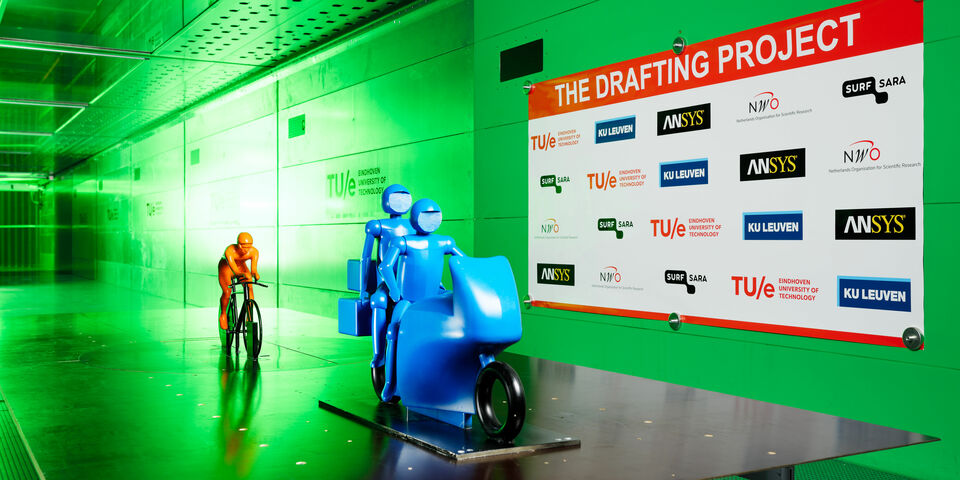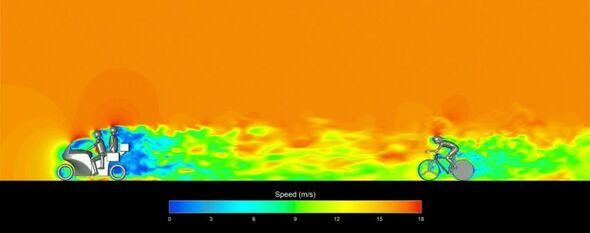Time gain for cyclist behind motorcycle much bigger than expected
In professional cycling, in-race motorcycles such as TV motorcycles drive in between the riders. In the slipstream behind the motorcycle, cyclists can gain time. For the first time, the exact extent of this advantage has been scientifically investigated. It turns out to be even more advantageous than expected. Using computer simulations and wind tunnel measurements, Professor Bert Blocken of TU/e and KU Leuven investigated the effect.
In recent years, many cycling teams, riders and commentators have complained that the motorcycles influence the races, and sometimes even determine the results. However, the exact extent of the advantage for a rider cycling behind a motorcycle had not been investigated before. It is not uncommon for motorcyclists to remain in front of a single rider or a group of riders at twenty to thirty meter for several minutes. Even distances of a few meter occur in short bursts.
Professor of Building Physics Bert Blocken is surprised at the enormous time gains that his research shows: “Even if a motorcyclist only rides for a few seconds in front of the riders, a considerable time advantage can still be gained. For a rider cycling for 10 seconds at 2.5 meters behind a motorcycle, this gain can exceed 2 seconds.”
Winning or losing
Blocken investigated the drag using two methods that independently show the same results: computer simulations and measurements in the TU/e wind tunnel. A rider who cycles at a distance of approximately 2.5 meters from a motorcyclist experiences up to 48 % less drag. If he or she would ride at 54 km/h without motorcycle, the presence of the motorcycle will allow him or her to ride at about 67 km/h. This provides a time gain of 14.1 seconds every minute. This advantage becomes smaller as the distance increases, but at a distance of 50 meters a 7% reduction is still measurable. This represents a gain of 1.4 seconds per minute at a reference speed of 54 km/h. At reference speeds above 54 km/h, the time gain is even bigger.
"We repeated the wind tunnel measurements and our calculations a few weeks after the first tests because I couldn't believe the size of the effects. But we always found the same results. Because races are sometimes decided by seconds, these differences can determine whether you win or lose. The often-heard complaint that motorcycles can influence the outcome of races is therefore justified," says Blocken.
The time gains cited above are calculated and measured without head wind, tail wind or crosswind. Blocken: "If there is head wind, the time gains are larger. If there is tail wind or crosswind, the time gains are smaller. The stronger the crosswind, the more difficult it is for a rider to get in the motorcycle’s slipstream."
Insufficient and not enforced guidelines
The International Cycling Union UCI issued new guidelines for motorcyclists in 2017. Blocken's research shows that these are not sufficient to prevent time gain for the riders. Moreover, these rules are not enforced during the race, which means that in reality motorcycles are even closer to the riders.
Fred Grappe, Performance Director at the UCI World Tour Team Groupama-FDJ, believes that Blocken's study should have consequences. “It is necessary to define a kind of ‘free zone’ around the rider in which no motor vehicle is allowed for more than a few seconds. Bert Blocken's new scientific study in cycling dynamics provides the knowledge to determine such a zone effectively. Given the influence of even a few seconds on a ranking, it is unacceptable to ignore this knowledge and its importance.”
Supercomputer for complex calculations
Blocken has previously presented studies towards time gained with motorcyclists who ride next to or behind riders. That he had not previously investigated the motorcyclist in front of the rider is down to the difficulty to predict the strongly fluctuating airflow between the motorcyclist and the rider, especially at larger distances between them. Blocken: “This makes the calculation so complex that standard calculation models were no longer sufficient.” Because of the intensive calculations, Blocken used the Dutch national supercomputer Cartesius at SURF and the ANSYS Cloud.




Discussion